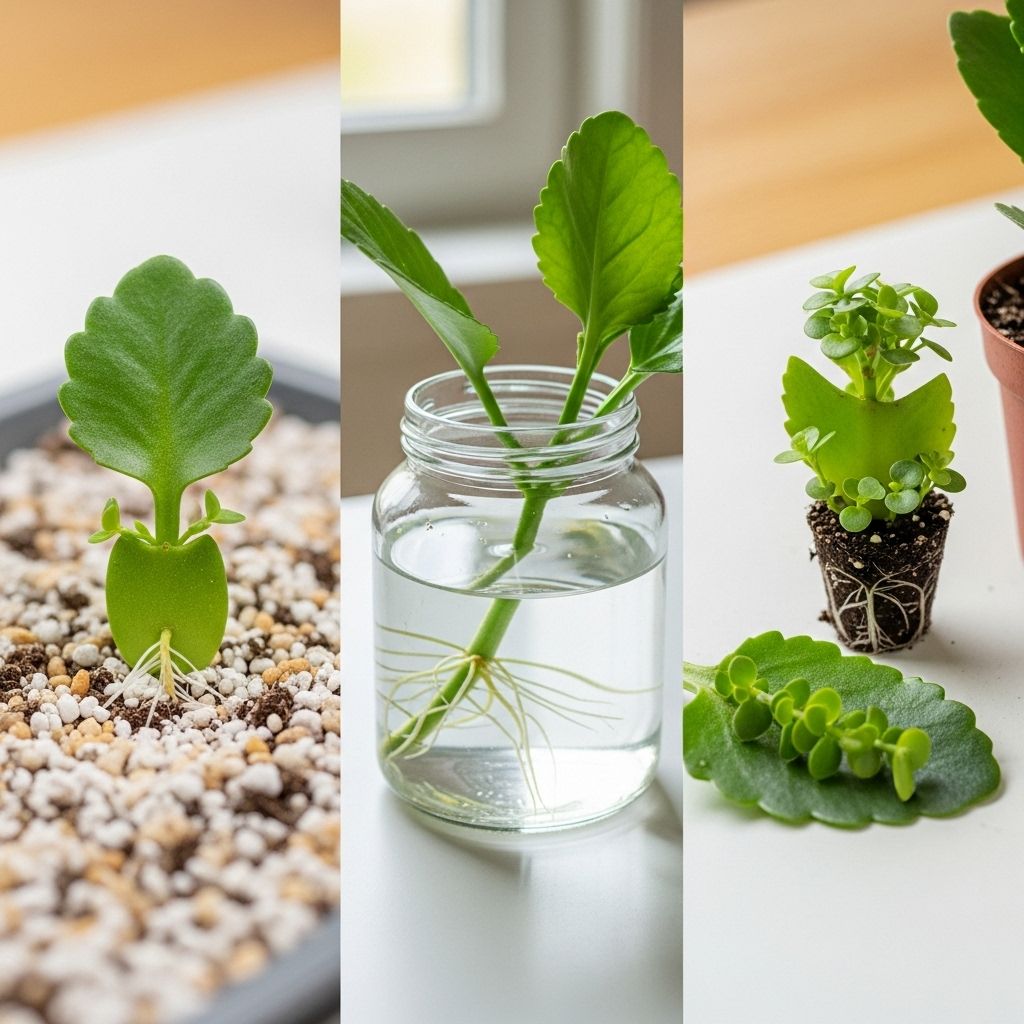How To Propagate Kalanchoe: 3 Simple Indoor Methods
Easily propagate kalanchoe and enjoy vibrant blooms all year round with these simple steps.

Image: HearthJunction Design Team
Introduction to Kalanchoe Propagation
Kalanchoe plants are known for their vibrant blooms and simplicity in care. They are ideal for indoor gardens and can thrive even during the cold months, making them a popular choice for gardeners of all levels. Propagating kalanchoe is straightforward and can be done using stem cuttings or offsets. This guide will walk you through the process of propagating kalanchoe using these methods.
Materials Needed for Propagation
To propagate kalanchoe successfully, you will need the following materials:
- A healthy kalanchoe plant – Choose a plant with no signs of disease or pests.
- A sharp, clean knife or clippers – Essential for making clean cuts on the stem.
- A pot – Preferably a clay pot to regulate moisture.
- Succulent and cactus soil – This type of soil ensures proper drainage.
- Rooting hormone powder (optional) – Enhances the chances of successful root development.
- A clear plastic bag – To maintain humidity around the new plant.
- Misting bottle or watering can – For gentle watering.
Propagating Kalanchoe Using Stem Cuttings
Using stem cuttings is one of the most common methods for propagating kalanchoe. It involves cutting a section of the stem and allowing it to develop roots.
Here are the steps to follow:
- Identify a Healthy Stem: Choose a stem that is about 2-3 inches long and has at least four to five leaves. Cut just above a leaf node.
- Allow the Cutting to Dry: Let the cut end of the stem dry for two to three days. This helps prevent rot and disease.
- Use Rooting Hormone (Optional): Dip the dried end of the cutting into rooting hormone powder to enhance root development.
- Prepare the Soil: Fill a small pot with a succulent and cacti mix.
- Plant the Cutting: Place the stem cutting in the soil and water gently to moisten the soil.
- Maintain Humidity: Cover the pot with a clear plastic bag to maintain humidity.
- Provide Proper Light: Place the pot in bright, indirect light. Roots should develop within a few weeks.
Propagating Kalanchoe Using Offsets
Some kalanchoe varieties, like the “Mother of Thousands,” produce offsets that can be used for propagation. These offsets usually grow from the leaf notches and have small roots already developed.
Here’s how to propagate kalanchoe using offsets:
- Collect Offsets: Gently collect the offsets from your kalanchoe plant, ensuring each has at least two to three roots.
- Handle with Care: Use tweezers to handle the delicate offsets.
- Plant the Offsets: Plant them in a pot with moist succulent and cacti mix.
- Maintain Moisture: Mist the soil regularly to keep it damp.
- Transplant: Once the roots have established and the young plants have grown, transplant them into individual pots.
- Provide Proper Light: Place the new plants in a location with indirect sunlight.
Leaf Propagation Method
Although less common, some kalanchoe varieties can be propagated using leaves. This method is similar to stem cuttings but involves using individual leaves:
– Choose a Healthy Leaf: Select a firm, healthy leaf.
– Cut the Leaf: Cut the leaf from the plant, leaving a small piece of stem attached.
– Allow to Dry: Let the cut end dry for a few days.
– Plant the Leaf: Place the leaf in a pot with succulent soil and water gently.
– Maintain Humidity: Cover with a plastic bag and provide indirect light.
Common Challenges and Solutions
During propagation, you might encounter a few challenges. Here are some common issues and how to address them:
- Rotting: Avoid overwatering. Ensure the soil has good drainage, and the pot allows for air circulation.
- Slow Root Development: Check if the room temperature is suitable (around 65°F to 75°F) and ensure the plant is not exposed to direct sunlight.
- Pests: Inspect the plant regularly for signs of pests and treat promptly if necessary.
Frequently Asked Questions (FAQs)
Q: How long does it take for kalanchoe cuttings to root?
A: Typically, kalanchoe cuttings take about 15 to 20 days to develop roots.
Q: Can kalanchoe be propagated in water?
A: While it is technically possible to root kalanchoe cuttings in water, using soil is generally more reliable and easier to manage.
Q: How often should I water newly propagated kalanchoe plants?
A: Water gently but avoid overwatering. The soil should be moist but not saturated.
Conclusion
Propagating kalanchoe is a rewarding process that allows you to multiply your favorite succulents easily. By following these steps, you can enjoy a vibrant collection of kalanchoe plants, each with its unique colors and patterns.
Remember, patience is key. Allow your cuttings or offsets the time they need to develop roots, and soon you’ll be enjoying the beauty of your new kalanchoe plants.
References
Read full bio of Shinta












